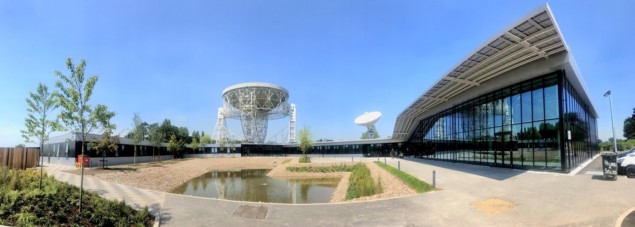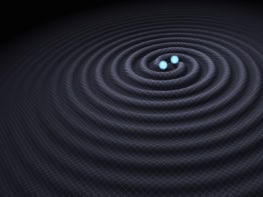
The New Zealand government has announced that it will pull out of the Square Kilometre Array (SKA), an ambitious international project to build a vast radio telescope spread out over two continents. The decision comes in the wake of numerous delays and rising costs, as well as heated discussions within New Zealand about the wisdom of spending billions on a project that, it fears, would benefit few astronomers.
As its name suggests, the SKA is a facility intended to have a total collecting area of 1 km2. That will be achieved by spreading out thousands of individual dishes in southern Africa as well as around a million wire antennas in Australia . SKA is designed to provide astronomers with unprecedented views of the first stars in the universe and observations of gravitational waves via the radio emissions from pulsars, among other things.
However, it is not clear when the complete observatory – with a likely price tag of several billion Euros – will see the light of day. As such, scientists are for now concentrating on building a much smaller preliminary facility known as SKA1. But even that is proving troublesome. The project’s organisers are struggling to contain SKA1’s costs below a ceiling imposed by member countries – currently €691m – while the start of scientific observations has been pushed back repeatedly – from an initial date of 2017 to now around 2027.
To stop supporting this team is to risk losing their specialist skills and expertise
Willem van Straten
New Zealand is currently one of 10 full member countries that currently make up the SKA Organisation, which coordinates the telescope’s design and is based at Jodrell Bank in the UK. However, the country has now decided not to take part in building the project, which is due to begin in 2020. The plan was that New Zealand would have been an associate member of the SKA Observatory — an intergovernmental body also housed at Jodrell Bank that will oversee construction of the facility. The group was formed in March when Australia, China, Italy, the Netherlands, South Africa and the UK signed a treaty in Rome. Of the other three existing members, India and Sweden are preparing to sign up while Canada may instead become an associate member. One non-member nation — Portugal — also signed the treaty too.
A political effort
New Zealand’s decision to quit SKA was announced by its Ministry of Business, Innovation and Employment on 2 July after concluding that the benefits of continued membership “are not sufficient to account for its cost”. Government official Simon Rae says the ministry estimated that ten years of associate membership would have cost up to NZ$40m when factoring in the NZ$20m-30m that it would have been needed to expand the country’s radio astronomy community. Joining the construction phase, he explains, “would only make sense if New Zealand could sufficiently utilise a share in the completed radio telescope”.
One prominent critic of the SKA, Richard Easther, a cosmologist and head of physics at the University of Auckland, maintains that New Zealand’s involvement in the project was not driven by science. Instead, he argues, the motivation was “a political effort to deepen our relationship with Australia, with the spending then being justified in terms of the spinoffs”.
Easther argues that the case for joining was significantly weakened after New Zealand’s bid to host some of the telescope’s dishes (alongside Australia) fell through when it was decided in 2012 to divide the project between Australia and South Africa. The subsequent delays and downsizing only made matters worse, he says. “The two-stage deployment was always part of the plan, but the timeline has stretched to the point where it amounts to a stealth-downsizing,” he says. “There is no realistic plan to fund or deploy SKA2, so it is off in the never-never.” Convention signed to establish governing body for the Square Kilometre Array
Easther has been in the middle of an unusually personal spat with some staff at the Auckland University of Technology (AUT). Andrew Ensor, an AUT computer scientist who is director of the New Zealand SKA Alliance, wrote an e-mail to technology journalist Peter Griffin warning him of Easther’s “single handed attempts to destroy NZ’s involvement and reputation in the SKA” and suggesting that the astrophysicist seek “medical help” rather than media attention.
Some New Zealand astronomers share Easther’s scepticism of the SKA, with 11 having joined him in writing a letter in December 2017 criticizing membership of the project. But others are disappointed. Willem van Straten, a radio astronomer at the AUT, argues that involvement would have “brought numerous opportunities for learning and discovery to New Zealand”. He describes the government’s assessment as “very short-sighted and pessimistic”, particularly given the involvement of numerous engineers and computer scientists in the project. “To stop supporting this team is to risk losing their specialist skills and expertise,” he says.
At least five countries must ratify the intergovernmental treaty before it can come into force. According to SKA Organisation director-general Philip Diamond, treaty signatories expect to do so by around spring next year. However, he refuses to be drawn on which countries, if any, have so far pledged specific funding. He says he is “very optimistic about the state of the project” but adds that he and his colleagues are “engaged quite heavily in negotiations at the moment”.
Timeline: The Square Kilometre Array
2006
Southern Africa and Australia are shortlisted to host the Square Kilometre Array (SKA) beating off competition from Brazil and China. Due to be completed in 2020 and cost €1.5bn, the facility would comprise about 4000 dishes, each 10 m wide, spread over an area 3000 km across
2012
The SKA Organisation fails to pick a single site for the telescope and decides to split the project between Southern Africa and Australia
Philip Diamond is appointed SKA’s first permanent director-general replacing the Dutch astronomer Michiel van Haarlem, who had been interim SKA boss
2013
Germany becomes the 10th member of SKA, joining Australia, Canada, China, Italy, the Netherlands, New Zealand, South Africa, Sweden, the UK
SKA’s temporary headquarters at Jodrell Bank in the UK opens
SKA members propose a slimmed-down version of SKA known as SKA1. With a cost cap of €691m, it would consist of 250 dishes in Africa and about 250 000 antennas in Australia
2014
Germany announces it will pull out of SKA the following year
2015
Jodrell Bank beats off a bid by Padua in Italy to host SKA’s headquarters
India joins SKA
2017
Members scale back SKA again following a price hike of €150m, which involves reducing the number of African dishes to 130 and spreading them out over 120 km
2018
The first prototype dish for SKA is unveiled in China
Spain joins SKA
2019
Convention signed in Rome to create an intergovernmental body known as the SKA Observatory
The Max Planck Society in Germany joins SKA
New Zealand announce it will pull out of SKA in 2020



